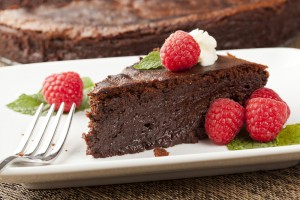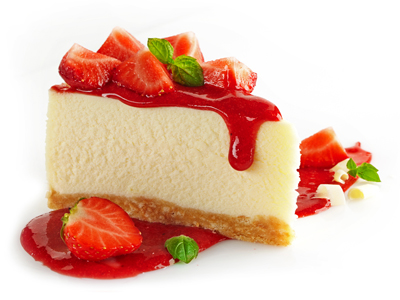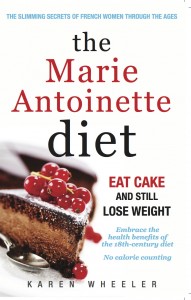Karen Wheeler, a former fashion and beauty editor, gained ten kilos (1st 8lb) while living in France and was determined to find a way of shedding the pounds without cutting out the food she loved. Her book The Marie Antoinette Diet: Eat Cake and Still Lose Weight tells the story of how she did it
Convinced that a diet involving deprivation and calorie counting was not the way to go, Wheeler found a recipe that worked for her quite by chance while buried in a biography of Marie Antoinette. Using the argument that cake in the morning means calories are burned throughout the day and cravings stay curbed later, the book attempts to explain how French women eat rich, fatty food while still managing to stay slim and avoid heart disease.
The queen’s diet of hot chocolate and cake in the morning followed by a light evening meal of broth and chicken, Wheeler claims, would have helped her retain her famously small waistline by allowing her muscles to burn fat cells for energy at night, rather than excess glucose.

As she delved deeper into her research, the Antoinette Diet author discovered many other things that 18th-century French society did conducive to weight loss such as eating soup (which she says, keeps you fuller for longer), avoiding processed food and balancing out calories on a daily basis.
Although peppered with scientific evidence (and a whole lot of studies on mice), Wheeler does admit she is ‘not a dietician’ and that a lot of the research she came across while writing the book was contradictory.
Here at Healthista, we weren’t sure if a diet that let us have our cake and eat it too – for breakfast – was too good to be true. We’ve taken a look at the diet’s claims and provided a verdict for you.
What’s the evidence for a cake diet?
Studies on mice have shown that eating during a time when they would normally be inactive meant that glucose was more likely to be stored as fat, but that eating at a time of high activity meant calories were more likely to be burned as energy or used for tissue building.
However, humans are (obviously) not the same as mice, and although similar on a molecular level there is no certainty that the findings can apply to both species. Also, and a big give away, Karen Wheeler does admit when talking about cake for breakfast that common sense with regards to portion size is key.
As Wheeler also crucially admits: ‘obviously, you’ll lose weight faster if you forgo the daily pleasure of cake’. She also points out that ‘the caffeine and carb combo’ spells terrible news for blood sugar levels and therefore for dieters. (Doh!)
Healthista’s verdict on the Cake Diet theory

2. A 12 hour nightly fast to aid weight loss. At night, glycogen stored in the muscles and liver is converted into glucose and released into the bloodstream to keep blood sugar levels steady while we sleep. Once stores have been used up, the liver starts burning fat cells for energy. However in people who top up their calorific intake during resting hours, the liver will not have a chance to go into fat-burning mode meaning they are far less likely to lose weight. Healthista verdict: If you can manage it, a 12 hour nightly fast can help with weight loss and it’s do-able for most people on some nights of the week.
3. Soup for dinner. Research has found that when water is blended with food before consumption the effect is more filling than when water and food enter the body separately. This is because the valve at the bottom of the stomach holds back food until the digestive juices have done their work but allows water to pass through. When the same ingredients are eaten as soup however, the entire mixture remains in the stomach for digestion, making you feel fuller for longer. Healthista verdict: It’s been proven in a number of studies that eating soup and smoothies as meals keeps hunger at bay.
4. Eat like they did in the 18th-century. Studies have found that we can all benefit from eating like they did in an era when hydrogenated fats and packaged food did not exist. With livestock fed on pasture and raised in sunlight rather than in industrial sheds, the food of Marie Antoinette’s era would naturally have contained more nutrients than the modern-day equivalent. In addition to this, much modern food is far too processed, leaving people over-fed but undernourished as a result. Healthista verdict: we’ll never, ever argue with someone saying we should eat less processed food.
5. Avoid trans fats, margarine and low-fat spreads. Although cheap and long lasting, trans fats are now universally regarded as damaging to the human body because they interfere with metabolic systems, increase the risk of heart disease and encourage weight gain. Despite previous warnings, new research has suggested that natural saturated fats are a healthier alternative as they boost your energy and improve digestion. Healthista verdict: yes, yes, YES. Organic butter is better by miles than any of those processed fats. It’s natural and you only need a little to make food more digestible and satisfying.
The Marie Antoinette Diet works on the basis that to be a successful slimmer you have to control your cravings, so by allowing yourself a little bit of what you fancy as part of your plan you will be less likely to ditch the diet and overindulge. However, you will lose more weight if you cut the cake all together and opt for a good protein-based breakfast such as an omelette, porridge and nuts or a protein smoothie.
The Marie Antoinette Diet: Eat Cake and Still Lose Weight (Sweet Pea Publishing, £7.99) is available from Amazon.
Like this article? Sign up to our newsletter to get more articles like this delivered straight to your inbox.






















































